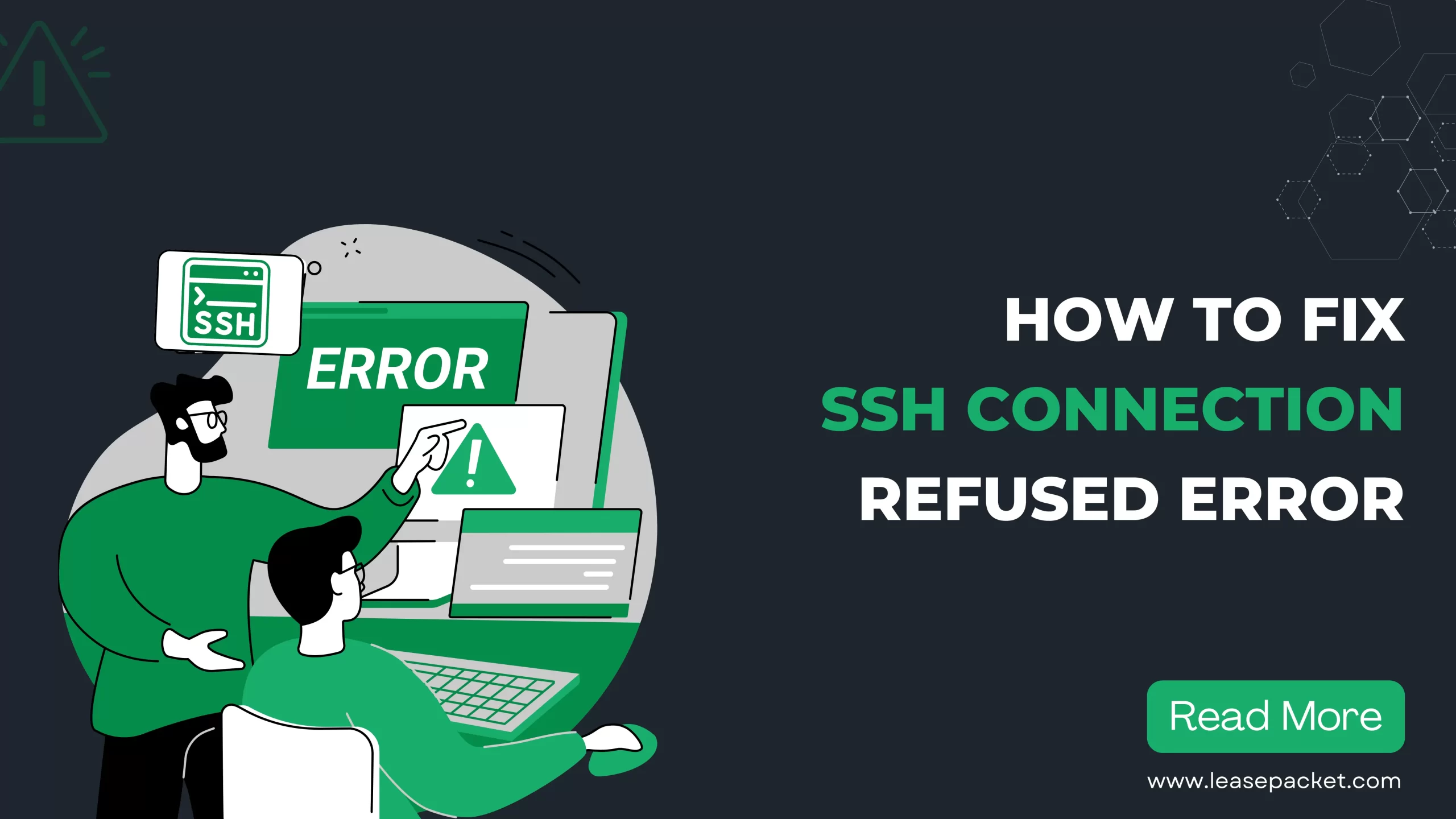SSH (Secure Shell) is a widely used protocol for securely connecting to remote servers over a network. However, encountering a “Connection Refused” error while attempting SSH can be irritating. This error occurs when the SSH server refuses a connection request from a client. It can happen for several reasons. In this article, we embark on a journey to decode SSH connection refused errors and provide simple solutions to troubleshooting to ensure smooth remote access to your systems.
Table of Contents
What is SSH Connection Refused Error?
SSH is a cryptographic protocol for securely accessing and managing remote servers over an unsecured network. The “Connection Refused” error occurs when an attempt to establish an SSH connection to a server fails. This error typically stems from issues related to the SSH service configuration, network connectivity, firewall blocking the SSH port, incorrect SSH credentials, or authentication settings.
Why is It Important to Fix the SSH “Connection Refused” Error?
Fixing the SSH “Connection Refused” error is crucial because it prevents you from accessing your remote server, which can hinder your ability to perform necessary tasks such as managing files, executing commands, or configuring settings. Moreover, if left unresolved, it may indicate underlying issues with your server’s network configuration or SSH service, potentially leading to security vulnerabilities or service disruptions.
Specific reasons why fixing the SSH “Connection Refused” Error is essential:
- Restoring access to the server
- Troubleshooting server-related issues
- Securing remote access to the server
- Maintaining efficient workflow
- Preventing data loss & downtime
What are the Causes of the SSH Connection Refused Error?
When attempting to establish an SSH connection, encountering a “Connection Refused” error indicates that the SSH server has rejected the connection request. Let’s understand the potential causes and discuss ways to troubleshoot the SSH Connection Refused error.
1. SSH Port is Wrong
By default, SSH servers listen for incoming connections on port 22. When the server is configured to listen on a different port or if the client attempts to connect to the wrong port – the connection will be refused. To resolve this, update the SSH client configuration to specify the correct port or adjust the SSH server’s port configuration. Use the following command to get a list of ports with the LISTEN state on your server:
[sudo lsof -i -n -P | grep LISTEN]
After the command, port 22 or your server’s custom SSH port will appear. If that doesn’t happen, you must reopen the port to connect to your server.
2. Incorrect Credentials
An incorrect username or password provided during the SSH authentication process will result in a connection refusal. Ensure the credentials entered are accurate, including proper capitalization and any special characters. If uncertain, try accessing the server using alternative credentials or resetting the password.
Check which port is being used for SSH by running this command:
[grep Port /etc/ssh/sshd_config]
The correct port will be shown after entering the command. Ensure the entrance of accurate credentials, IP address, or port.
3. SSH Client is Not Installed
If the SSH client software is not installed on the user’s system, attempts to establish an SSH connection will fail. Install the SSH client software using the appropriate package manager for your operating system. For example, on Linux systems, install OpenSSH-client, and on Windows, consider using PuTTY or OpenSSH available through optional features.
4. SSH Daemon is Not Installed on the Server
The SSH daemon (sshd) must be installed and running on the server to accept incoming SSH connections. Use the package manager of your server’s operating system to install the OpenSSH server package. Once installed, start the SSH daemon using the appropriate system command (e.g., systemctl start sshd for Linux).
5. SSH Services are Disabled
If the SSH service is disabled on the server, it will not be able to accept incoming connections. Check the status of the SSH service using system-specific commands (e.g., systemctl status sshd for Linux or services.msc for Windows). If the service is disabled, enable and configure it to start automatically upon system boot to ensure continuous availability. Use these commands if needed – systemctl start sshd or the equivalent command for your operating system.
6. Firewall Prevents SSH Connection
Firewalls – on the client or server side, may block SSH connections. Check the firewall settings on both ends to ensure that traffic on the SSH port (default is 22) is allowed. If the firewall is blocking SSH traffic, adjust the firewall rules to permit SSH connections or consider using a different port for SSH communication.
There is a way to know if the SSH connection is being prevented by the firewall. Use these commands to view the firewall rules:
[sudo iptables-save # display IPv4 rules]
[sudo ip6tables-save # display IPv6 rules]
Then, look for these in command results:
dport 22: Referring to the destination port (usually port 22).
REJECT: Indicating connection refusal from the defined destination.
DROP: It means connections to the appropriate port are blocked.
Now, for dport 22, search the results of the commands above – and you will know if your firewall is preventing an SSH connection. If it’s a yes, change the rules to accept requests.
7. Incorrect SSH Configuration
Misconfigurations in the SSH server or client settings can prevent successful connections. Ensure the SSH server is configured to accept incoming connections and that the client has the correct credentials and settings. Check the SSH configuration files (sshd_config on the server and ssh_config on the client) for errors or inconsistencies. Pay attention to parameters such as Port, AllowUsers, and PasswordAuthentication.
8. Network Issues
Network connectivity problems, such as congestion or router issues, can disrupt SSH connections. Ensure both the client and server have stable network connections with sufficient bandwidth. Troubleshoot network issues using tools like ping to test connectivity and traceroute to identify network hops and potential bottlenecks.
9. Resource Constraints
Insufficient system resources on the server, such as CPU or memory constraints, can impact SSH connections. Monitor system resource usage using tools like Top or Task Manager and address resource limitations. Consider optimizing system performance by reducing unnecessary processes or upgrading hardware if necessary.
10. IP Address Restrictions
SSH servers may be configured to allow connections only from specific IP addresses or ranges. The connection will be refused if the server’s configuration does not permit the IP address. Review the server’s sshd_config file and ensure that your IP address is included in the AllowUsers or AllowGroups directives, if applicable.
How to Fix SSH Connection Refused Error?
Now that we have identified the potential causes of SSH connection refused errors, let’s outline the troubleshooting steps to address each issue effectively.
1. Check SSH Configuration
Verify the SSH server configuration file (sshd_config) for syntax errors or misconfigurations. Ensure the SSH service is configured to listen on the correct port and accept incoming connections. Review client-side SSH configuration (ssh_config) for any discrepancies.
2. Adjust Firewall Settings
Check firewall rules to ensure SSH traffic is allowed through the appropriate ports (typically port 22). Add firewall rules to permit SSH traffic if necessary, using tools like iptables or Windows Firewall.
3. Start SSH Service
If not running, start the SSH service using the appropriate system command (systemctl start sshd, services.msc, etc.).
4. Troubleshoot Network Connectivity
Use network diagnostic tools like ping and traceroute to identify and resolve network connectivity issues. Ensure both the client and server have stable network connections with sufficient bandwidth.
5. Verify Authentication Credentials
Double-check the username & password being used for SSH authentication. If using SSH keys, ensure the correct public key is added to the server’s authorized_keys file.
6. Monitor System Resources
Monitor system resource usage using tools like top, Task Manager, or Resource Monitor. Address any resource constraints by optimizing system performance or upgrading hardware.
7. Review IP Address Restrictions
Verify that your IP address is allowed by the server’s configuration, especially if IP address restrictions are in place. Add your IP address to the server’s AllowUsers or AllowGroups directives if necessary.
Conclusion
SSH connection refused errors can be daunting, but with a systematic approach to troubleshooting, they can be resolved. By understanding the common causes of these errors and following the outlined troubleshooting steps, you can ensure smooth SSH connections to your servers & devices. Remember to document any changes made during the troubleshooting process for future reference. Now, you can overcome SSH connection-refused errors and maintain smooth remote access to your systems. If you seek technical help with this error, connect with top server provider Company like Leasepacket.
FAQs
Q1. What should I do if I encounter the SSH Connection Refused error?
Check if the SSH port number is correct and adjust it if necessary. Ensure that your credentials are accurate and that the SSH service is enabled on the server. Verify that the SSH client software is installed on your system and that the SSH Daemon is active on the server. Additionally, review firewall settings to allow SSH connections. You can also reread this article or connect with top server providers like Leasepacket.
Q2. How can I change the SSH port number?
To change the SSH port number, edit the SSH server configuration file (usually located at /etc/ssh/sshd_config) and modify the Port directive to specify the desired port number. After making the changes, restart the SSH service for the configuration to take effect.
Q3. What should I do if my SSH credentials are incorrect?
Double-check the username & password entered for the SSH connection, ensuring correct capitalization and any special characters. If unsure, try accessing the server using alternative credentials or resetting the password.
Q4. How can I ensure that SSH is enabled on the server?
Use system-specific commands (e.g., systemctl status sshd for Linux) to check the status of the SSH service on the server. If the service is not running, start it using the appropriate command and configure it to start automatically upon system boot.
Q5. What steps should I take if the SSH client is not installed on my system?
Install the SSH client software using the package manager of your operating system. For Linux systems, install the OpenSSH client package, and for Windows, consider installing PuTTY or enabling OpenSSH through optional features.
Q6. What should I do if my firewall is preventing SSH connections?
Review the firewall settings on both the client and server sides to ensure that traffic on the SSH port (default is 22) is allowed. Adjust the firewall rules to permit SSH connections or consider temporarily disabling the firewall for testing purposes.

























